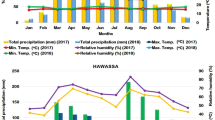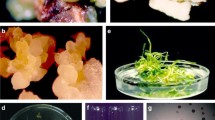Abstract
Multiple infections of Sweet potato feathery mottle virus (SPFMV), Sweet potato chlorotic stunt virus (SPCSV), Sweet potato virus G (SPVG) and Sweet potato mild mottle virus (SPMMV) cause a devastating synergistic disease complex of sweet potato (Ipomoea batatas Lam.) in KwaZulu-Natal, South Africa. In order to address the problem of multiple virus infections and synergism, this study aimed to develop transgenic sweet potato (cv. Blesbok) plants with broad virus resistance. Coat protein gene segments of SPFMV, SPCSV, SPVG and SPMMV were used to induce gene silencing in transgenic sweet potato. Transformation of apical tips of sweet potato cv. Blesbok was achieved by using Agrobacterium tumefaciens strain LBA4404 harboring the expression cassette. Polymerase chain reaction and Southern blot analyses showed integration of the transgenes occurred in six of the 24 putative transgenic plants and that all plants seemed to correspond to the same transformation event. The six transgenic plants were challenged by graft inoculation with SPFMV, SPCSV, SPVG and SPMMV-infected Ipomoea setosa Ker. Although virus presence was detected using nitrocellulose enzyme-linked immunosorbent assay, all transgenic plants displayed delayed and milder symptoms of chlorosis and mottling of lower leaves when compared to the untransformed control plants. These results warrant further investigation on resistance to virus infection under field conditions.



Similar content being viewed by others
References
An G, Ebert PR, Mitra A, Ha SB (1988) Binary vectors. Plant Mol Biol Man A3:1–19
Cipriani G, Fuentes S, Bello V, Salazar LF, Ghislain M, Zhang DP (2001) Transgene expression of rice cysteine proteinase inhibitors for the development of resistance against Sweet potato feathery mottle virus. In: Fergusson P, Parrott S, Sheridan K, Smith B, Stares J (eds) CIP program report 1999–2000. International Potato Center, Lima, pp 267–271
Clark CA, Hoy MW (2007) A tospovirus in the sweetpotato virus complex. 2007 Southern Division Meeting Abstracts. http://www.apsnet.org/members/divisions/south/meetings/ Pages/2007MeetingAbstracts.aspx
Clark CA, Valverde RA, Fuentes S, Salazar LF, Moyer JW (2002) Research for improved management of sweet potato pests and diseases: cultivar decline. Acta Hortic 583:103–113
Clark CA, Davis JA, Abad JA, Cuellar WJ, Fuentes S, Kreuze JF, Gibson RW, Mukasa SB, Tugume AK, Tairo FD, Valkonen JPT (2012) Sweetpotato viruses: 15 years on understanding and managing complex diseases. Plant Dis 96:168–185
Domola MJ, Thompson GJ, Aveling TAS, Laurie SM, Strydom H, Van den Berg AA (2008) Sweet potato viruses in South Africa and the effect of viral infection on storage root yield. Afr Plant Prot 14:15–23
Gama MICS, Leite RP, Cordeiro AR, Cantliffe DJ (1996) Transgenic sweet potato plants obtained by Agrobacterium tumefaciens-mediated transformation. Plant Cell Tissue Organ Cult 46:237–244
Gibson RW, Kaitisha GC, Randrianaivoriavony JM, Vetten HT (1998) Identification of the East African strain of Sweet potato chlorotic stunt virus (SPCSV) as a major component of sweet potato virus disease (SPVD) in southern Africa. Plant Dis 82:1063
Gibson RW, Aritua V, Byamukama E, Mpembe I, Kayongo J (2004) Control strategies for sweet potato virus disease in Africa. Virus Res 100:115–122
Gutiérrez-Campos R, Torres-Acosta JA, Saucedo-Arias LJ, Gomez-Lim MA (1999) The use of the cysteine proteinase inhibitors to engineer resistance against potyviruses in transgenic tobacco plants. Nat Biotechnol 17:1223–1226
Jan F-J (1998) Roles of nontarget DNA and viral gene length in influencing multi-virus resistance through homology dependent gene silencing. Ph.D. Dissertation, Department of Plant Pathology, Cornell University, Ithaca
Jan F-J, Fagoaga C, Pang S-Z, Gonsalves D (2000a) A minimum length of N gene sequence in transgenic plants is required for RNA-mediated tospovirus resistance. J Gen Virol 81:235–242
Jan F-J, Fagoaga C, Pang S-Z, Gonsalves D (2000b) A single chimeric transgene derived from two distinct viruses confers multi-virus resistance in transgenic plants through homology-dependent gene silencing. J Gen Virol 81:2103–2109
Karuri HW, Ateka EM, Amata R, Nyende AB, Muigai AWT (2009) Characterization of Kenyan sweet potato genotypes for SPVD resistance and high dry matter content using simple sequence repeat markers. Afr J Biotechnol 8:2169–2175
Karyeija RF, Gibson RW, Valkonen JPT (1998) The significance of Sweet potato feathery mottle virus in subsistence sweet potato production in Africa. Plant Dis 82:4–15
Karyeija RF, Kreuze JF, Gibson RW, Valkonen JPT (2000) Two serotypes of Sweetpotato feathery mottle virus in Uganda and their interaction with resistant sweetpotato cultivars. Phytopathology 90:1250–1255
Kokkinos CD, Clark CA, McGregor CE, LaBonte DR (2006) The effect of sweet potato virus disease and its viral components on gene expression levels in sweetpotato. J Am Soc Hortic Sci 131:657–666
Kreuze J (2002) Molecular studies on the Sweet Potato Virus Disease and its two causal agents. Ph.D. Dissertation, Uppsala, Swedish University of Agricultural Sciences, pp 24–33
Kreuze J, Fuentes S (2008) Sweetpotato viruses. In: Mahy BWJ, Van Regenmortel MHV (eds) Encyclopedia of virology. Academic Press, Amsterdam, pp 659–669
Kreuze JF, Salmolski KI, Lazaro MU, Chuquiyuri WJC, Morgan GL, Mejla PGC, Ghislain M, Valkonen JPT (2008) RNA silencing- mediated resistance to a Crinivirus (Closteroviridae) in cultivated sweet potato (Ipomoea batatas L.) and development of sweetpotato virus disease following co-infection with a potyvirus. Mol Plant Pathol 9:589–598
Laurie LM (2002) Overview of breeding and evaluation of orange-fleshed sweet potato in South Africa. http://sweetpotatoknowledge.org/germplasm/breeding/Overview%20of%20Breeding%20and%20Evaluation%20of%20Orange-fleshed%20Sweetpotato%20in%20South%20Africa.pdf
Lin C-Y, Ku H-M, Tsai W-S, Green SK, Jan F-J (2011) Resistance to a DNA and a RNA virus in transgenic plants by using a single chimeric transgene construct. Transgenic Res 20:261–270
Loebenstein G, Thottappilly G, Fuentes S, Cohen J (2009) Viruses and phytoplasma diseases. In: Loebenstein G, Thottappilly G (eds) The sweet potato. Springer publications, The Netherlands, p 114
Lomonossoff GP (1995) Pathogen-derived resistance to plant viruses. Annu Rev Phytopathol 33:323–343
Luo HR, Santa Maria M, Benavides J, Zhang DP, Zhang YZ, Ghislain M (2006) Rapid genetic transformation of sweetpotato [Ipomoea batatas (L.) Lam] via organogenesis. Afr J Biotechnol 5:1851–1857
Miano DW, LaBonte DR, Clark CA (2008) Identification of molecular markers associated with sweet potato resistance to sweet potato virus disease in Kenya. Euphytica 160:15–24
Morán R, García R, López A, Zaldúa Z, Mena J, García M, Armas R, Somonte D, Rodríguez J, Gómez M, Pimentel E (1998) Transgenic sweet potato plants carrying the delta-endotoxin gene from Bacillus thuringiensis var. tenebrionis. Plant Sci 139:175–184
Moyer JW, Salazar LF (1989) Virus and virus-like diseases of sweet potato. Plant Dis 73:451–455
Mukasa SB, Rubaihayo PR, Valkonen JPT (2006) Interactions between a crinivirus, an ipomovirus and a potyvirus in coinfected sweet potato plants. Plant Pathol 55:458–467
Mwanga ROM, Yencho GC, Moyer JW (2002) Dialled analysis of sweetpotatoes for resistance to sweetpotato virus disease. Euphytica 128:237–249
Naylor RL, Falcon WP, Goodman RM, Jahn MM, Sengooba T, Telera H, Nelson RJ (2004) Biotechnology in the developing world: a case for increased investments in orphan crops. Food Policy 29:15–44
Newell CA, Lowe JM, Merryweather A, Rooke LM, Hamilton WDO (1995) Transformation of sweet potato (Ipomoea batatas Lam.) with Agrobacterium tumefaciens and regeneration of plants expressing cowpea trypsin inhibitor and snowdrop lectin. Plant Sci 107:215–227
Nyaboga EN, Ateka EM, Gichuki ST, Bulimo WD (2008) Reaction of transgenic sweet potato (Ipomoea batatas L.) lines to virus challenge in the glasshouse. J Appl Biosci 9:362–371
Okada Y, Saito A (2008) Evaluation of resistance to complex infection of SPFMVs in transgenic sweet potato. Breed Sci 58:243–250
Okada Y, Nishiguchi M, Saito A, Kimura T, Mori M, Hanada K, Sakai J, Matsuda Y, Murata T (2002) Inheritance and stability of the virus-resistant gene in the progeny of transgenic sweet potato. Plant Breed 121:249–253
Otani M, Shimada T, Kimura T, Saito A (1998) Transgenic plant production from embryogenic callus of sweet potato [Ipomoea batatas (L.) Lam] using Agrobacterium tumefaciens. Plant Biotechnol 15:11–16
Otani M, Wakita Y, Shimada T (2003) Production of herbicide-resistance sweetpotato (Ipomoea batatas (L.) Lam) plants by Agrobacterium tumefaciens-mediated transformation. Breed Sci 53:145–148
Pang S-Z, Jan F-J, Gonsalves D (1997) Nontarget DNA sequences reduce the transgene length necessary for RNA-mediated tospovirus resistance in transgenic plants. Proc Natl Acad Sci USA 94:8261–8266
Sanford JC, Johnston SA (1985) The concept of pathogen-derived resistance-deriving resistance genes from the parasite’s own genome. J Theor Biol 113:395–405
Sivparsad BJ (2013) The development of transgenic sweet potato (Ipomoea batatas L.) with broad virus resistance in South Africa. Ph.D. Dissertation, South Africa, University of KwaZulu-Natal, pp 60–81
Sivparsad BJ, Gubba A (2012a) Development of an efficient plant regeneration protocol for sweet potato (Ipomoea batatas L.) cv. Blesbok. Afr J Biotechnol 11:14982–14987
Sivparsad BJ, Gubba A (2012b) Molecular resolution of the genetic variability of major viruses infecting sweet potato (Ipomoea batatas L.) in the province of KwaZulu-Natal in the Republic of South Africa. Crop Prot 41:49–56
Song G-Q, Honda H, Yamaguchi K-I (2004) Efficient Agrobacterium tumefaciens-mediated transformation of sweet potato [Ipomoea batatas (L.) Lam.] from stem explants using a two-step kanamycin–hygromycin selection method. In Vitro Cell Dev Biol 40:359–365
Tairo F, Mukasa SR, Jones RAC, Kullaya A, Rubaihayo PR, Valkonen JPT (2005) Unraveling the genetic diversity of the three main viruses involved in sweet potato virus disease (SPVD), and its practical implications. Mol Plant Pathol 6:199–211
Untiveros M, Fuentes S, Salazar LF (2007) Synergistic interactions between Sweet potato chlorotic stunt virus (Crinivirus) with Carla-, Cucumo-, Ipomo- and Potyviruses infecting sweet potato. Plant Dis 91:669–676
Usugi T, Onuki M, Hayashi T (1990) Detection of some viruses by protein A sandwich ELISA (PAS-ELISA). Kyushu Agric Res 53:106
Valverde RA, Clark CA, Valkonen JPT (2007) Viruses and virus disease complexes of sweetpotato. Plant Viruses 1:116–126
Winter S, Purac A, Leggett F, Frison EA, Rossel HW, Hamilton RI (1992) Partial characterization and molecular cloning of a closterovirus from sweet potato infected with the sweet potato virus disease complex from Nigeria. Phytopathology 82:869–875
Xing Y-J, Ji Q, Yang Q, Luo Y-M, Li Q, Wang X (2008) Studies on Agrobacterium-mediated genetic transformation of embryogenic suspension cultures of sweet potato. Afr J Biotechnol 7:534–540
Yi G, Yang K, Kim K-M (2006) Sweetpotato transformation mediated by Agrobacterium tumefaciens. Korean J Breed 38:13–18
Acknowledgments
We thank Dennis Gonsalves from US Pacific Basin Agricultural Research Center, for providing the plant expression silencing (pEPJ86-m/2N) and transformation (pGA482G) vectors and Dr. P. Shanahan from the University of KwaZulu-Natal for providing the sweet potato cultivar ‘Blesbok’. BJS was sponsored by the National Research Foundation (NRF), South Africa for the entire duration of her studies for which she is eternally grateful.
Author information
Authors and Affiliations
Corresponding author
Electronic supplementary material
Below is the link to the electronic supplementary material.
Rights and permissions
About this article
Cite this article
Sivparsad, B.J., Gubba, A. Development of transgenic sweet potato with multiple virus resistance in South Africa (SA). Transgenic Res 23, 377–388 (2014). https://doi.org/10.1007/s11248-013-9759-7
Received:
Accepted:
Published:
Issue Date:
DOI: https://doi.org/10.1007/s11248-013-9759-7




